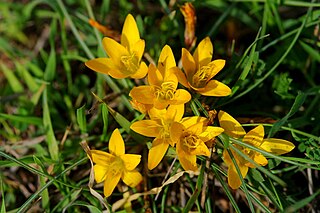
Saffron is a spice derived from the flower of Crocus sativus, commonly known as the "saffron crocus". The vivid crimson stigma and styles, called threads, are collected and dried for use mainly as a seasoning and colouring agent in food. Although some doubts remain on its origin, it is believed that saffron originated in Iran. However, Greece and Mesopotamia have also been suggested as the possible region of origin of this plant. Saffron crocus slowly propagated throughout much of Eurasia and was later brought to parts of North Africa, North America, and Oceania.

Crocus is a genus of seasonal flowering plants in the family Iridaceae comprising about 100 species of perennials growing from corms. They are low growing plants, whose flower stems remain underground, that bear relatively large white, yellow, orange or purple flowers and then become dormant after flowering. Many are cultivated for their flowers, appearing in autumn, winter, or spring. The flowers close at night and in overcast weather conditions. The crocus has been known throughout recorded history, mainly as the source of saffron. Saffron is obtained from the dried stigma of Crocus sativus, an autumn-blooming species. It is valued as a spice and dyestuff, and is one of the most expensive spices in the world. Iran is the center of saffron production. Crocuses are native to woodland, scrub, and meadows from sea level to alpine tundra from the Mediterranean, through North Africa, central and southern Europe, the islands of the Aegean, the Middle East and across Central Asia to Xinjiang in western China. Crocuses may be propagated from seed or from daughter cormels formed on the corm, that eventually produce mature plants. They arrived in Europe from Turkey in the 16th century and became valued as an ornamental flowering plant.

Crocus sieberi, Sieber's crocus, also referred to as the Cretan crocus or snow crocus, is a plant of the genus Crocus in the family Iridaceae. A small, early blooming crocus, it easily naturalises, and is marked by a brilliant orange which is mostly confined to the stamens and style, fading through the bottom third of the tepal. It grows wild generally in the Balkans and Greece, especially in the island Crete. There are four subtypes: sieberi (Crete), atticus, nivalis and sublimis. Its cultivars are used as ornamental plants. Height: 3–4 inches (7.6–10.2 cm).

Colchicum cilicicum, the Tenore autumn crocus, is a species of flowering plant in the Colchicaceae family. A bulbous perennial, it bears deep rose-lilac flowers in late summer, with barely any chequered pattern on the petals (tessellation). It has a very noticeable white stripe down the centre of each petal, which gives it a star-like appearance at the base. The flowers tend to stand up to weather better than other colchicum blooms. The flowers appear before the strap-like leaves, giving this and other colchicum species the common name “naked lady”. Although colchicums are called “autumn crocuses” they belong to a different family than true crocuses. There are in fact autumn-flowering species of crocus such as Crocus sativus, which is the source of the spice saffron. Colchicum cilicicum, by contrast, is toxic if eaten.

Crocus graveolens is a species of flowering plant in the family Iridaceae. It is native to Lebanon, Palestine, Syria, and Turkey.

Crocus hyemalis is a species of flowering plant in the family Iridaceae. It is referred to by the common name winter saffron and is native to Lebanon, the Palestine region and Syria.

Crocus carpetanus is a species of flowering plant in the Iridaceae family. It is native to Portugal and Spain.

Crocus baytopiorum is a species of flowering plant in the genus Crocus of the family Iridaceae. It is a cormous perennial native to Turkey.
Crocus vallicola is a species of flowering plant in the genus Crocus of the family Iridaceae. It is a cormous perennial native to north eastern Turkey to the western Caucasus.
Crocus asumaniae is a species of flowering plant in the genus Crocus of the family Iridaceae. It is a cormous perennial native to Turkey (Antalya).

Crocus abantensis is a species of flowering plant in the genus Crocus of the family Iridaceae. It is a cormous perennial native to northwestern Turkey.
Crocus antalyensis is a species of flowering plant in the genus Crocus of the family Iridaceae. It is a cormous perennial native to Turkey.
Crocus adanensis is a species of flowering plant in the genus Crocus of the family Iridaceae. It is a cormous perennial native to southern Turkey.
Crocus cvijicii is a species of flowering plant in the genus Crocus of the family Iridaceae. It is a cormous perennial native to northern Macedonia, eastern Albania, to northern Greece.
Crocus hermoneus is a species of flowering plant in the genus Crocus of the family Iridaceae. It is a cormous perennial native to Lebanon, Syria, and Palestine.

Crocus reticulatus is a species of flowering plant in the genus Crocus of the family Iridaceae. It is a cormous perennial native to central and southern European Russia, the northern Caucasus, the Transcaucasus, and Ukraine.
Crocus cyprius is a species of flowering plant in the genus Crocus of the family Iridaceae. It is a cormous perennial native to Cyprus where it is found in the Troödos Mountains.

Crocus veluchensis is a species of flowering plant in the genus Crocus of the family Iridaceae. It is a cormous perennial native to central and southern Albania, ranging to Bulgaria.
Crocus aerius is a species of flowering plant in the genus Crocus of the family Iridaceae. It is a cormous perennial native to Turkey.

Crocus danfordiae is a species of flowering plant in the genus Crocus of the family Iridaceae. It is a cormous perennial native to central and southern Turkey.












